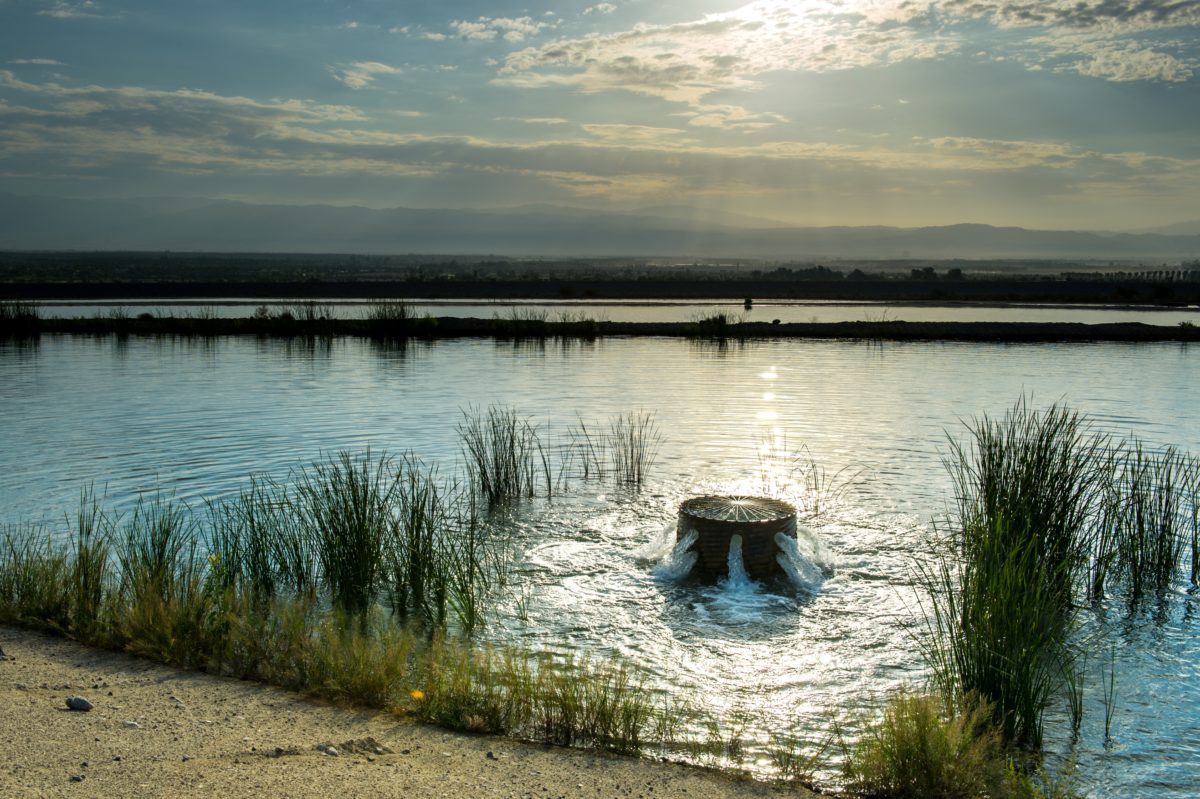
Groundwater recharge is an important water management practice in California.
- Recharge occurs when water seeps into the ground to replenish underground aquifers. Although some recharge happens incidentally—water flowing into the ground from rivers, unlined canals, or excess irrigation—intentional recharge can restore groundwater levels and store water for later use.
- In coastal areas, intentional recharge prevents salty ocean water from entering freshwater aquifers. Recharge can also help prevent impacts from groundwater pumping, such as dry wells or sinking lands, while providing wetland habitat for birds, reducing flood risk, and storing water for droughts.
- Active recharge is a longstanding practice in much of urban Southern California and parts of the Bay Area, Central Coast, and Central Valley.
Click here for the fact sheet in English from PPIC. Haga clic aquí para ver la hoja informativa en español de PPIC.
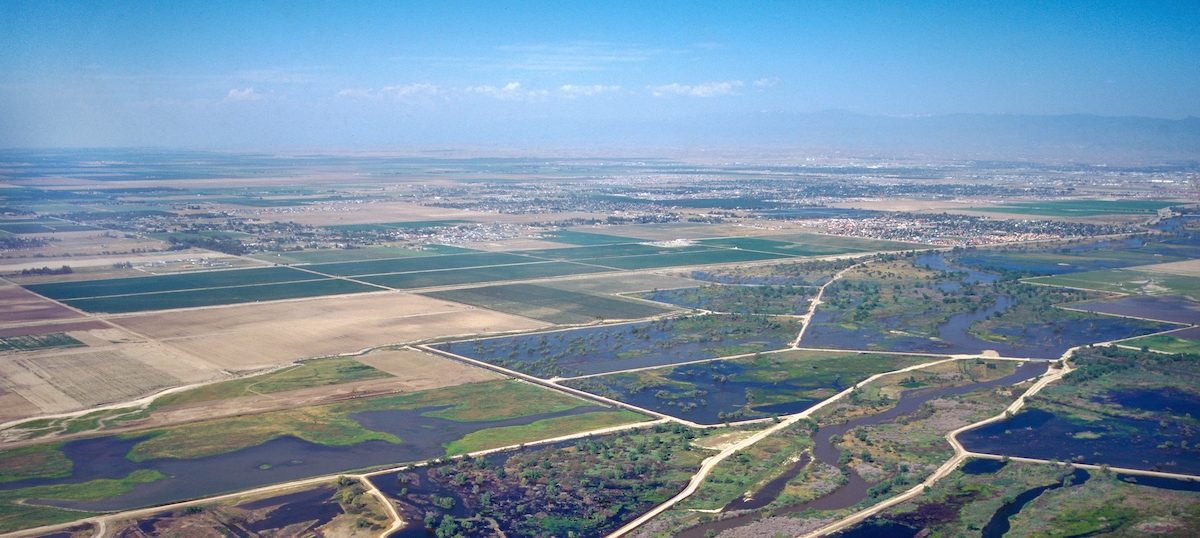
 From Sustainable Conservation:
From Sustainable Conservation:
Sustainable Conservation, a San Francisco- and Modesto-based non-profit, has developed two key resources to inform on-farm recharge practices that are protective of water quality.
Protecting Water Quality
Over 600,000 Californians rely on nitrate-contaminated public supply wells for their household water needs. Many others struggle with contaminated groundwater from private, domestic wells – so the numbers are even greater. Recharging groundwater with water quality as a top priority will help the San Joaquin Valley – our nation’s premier farming region – manage through California’s inevitable droughts, ensure safe drinking water for farm-adjacent communities, and support a thriving agricultural economy as the region complies with the Sustainable Groundwater Management Act.
Achieving Groundwater Sustainability
Conceived in coordination with a diverse group of stakeholders and supported by a committee of San Joaquin Valley leaders, our nitrate management brief and water quality research paper compile the best available science with Sustainable Conservation’s decade-plus of on-the-ground experience with groundwater recharge. Replenishing aquifers by allowing surface water to seep into the ground has great potential to help water managers and agricultural communities achieve groundwater sustainability. However, when recharging on farm fields – a practice known in water management circles as Agricultural Managed Aquifer Recharge (AgMAR) – the potential mobilization of nitrate and salts is a serious concern, and this guidance suite presents field- and regional-scale considerations to protect community water quality.
Sustainable Conservation will share its new guidance widely with growers, water managers, community organizers, and our broader audience of friends and supporters through our various events, webinars, and publications. For all media inquiries, please contact Christa Harader, Sustainable Conservation Digital Content Producer. If you need technical assistance or would like to request a small group presentation for your community or organization, please contact Taylor Broadhead, Sustainable Conservation Water and Dairies Project Manager.
Click here to read the full press release.

Groundwater recharge is an important water management practice in California.
-
- Recharge occurs when water seeps into the ground to replenish underground aquifers. Although some recharge happens incidentally—water flowing into the ground from rivers, unlined canals, or excess irrigation—intentional recharge can restore groundwater levels and store water for later use.
- In coastal areas, intentional recharge prevents salty ocean water from entering freshwater aquifers. Recharge can also help prevent impacts from groundwater pumping, such as dry wells or sinking lands, while providing wetland habitat for birds, reducing flood risk, and storing water for droughts.
- Active recharge is a longstanding practice in much of urban Southern California and parts of the Bay Area, Central Coast, and Central Valley.
Click here to view/download fact sheet. También disponible en español.

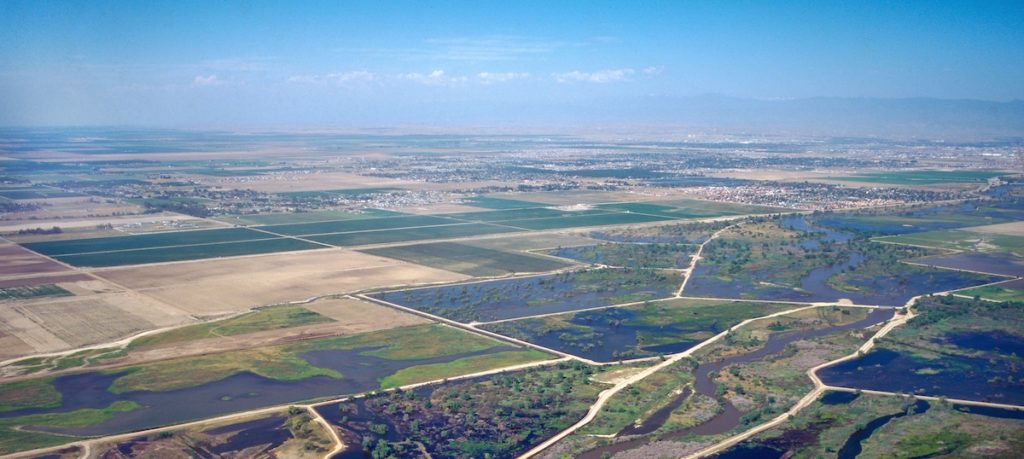 By the time California finally began regulating groundwater use in 2014, most of the San Joaquin Valley was in critical overdraft. The Public Policy Institute of California estimates that groundwater pumping in the region has exceeded replenishment by an average of 1.8 million acre-feet per year over the last few decades. This imbalance was even worse during our last drought, when overuse shot up to 2.4 million acre-feet per year.
By the time California finally began regulating groundwater use in 2014, most of the San Joaquin Valley was in critical overdraft. The Public Policy Institute of California estimates that groundwater pumping in the region has exceeded replenishment by an average of 1.8 million acre-feet per year over the last few decades. This imbalance was even worse during our last drought, when overuse shot up to 2.4 million acre-feet per year.
Overpumping puts groundwater aquifers at risk of compaction, permanently reducing their water storage capacity and making surface lands sink. Now, however, San Joaquin Valley groundwater managers must find and implement a fix. The state’s Sustainable Groundwater Management Act mandates balancing the region’s pumping with replenishment by 2040.
Managed aquifer recharge — diverting excess flood water so it can soak into the ground — is an obvious remedy. But accelerating recharge in the San Joaquin Valley is easier said than done. “Recharge is slow in silt and clay, and these are ubiquitous across the Central Valley,” explains Graham Fogg, an emeritus hydrogeologist at UC Davis.
Fogg and colleagues have found a new way to speed recharge in the Central Valley: ancient river channels where water can shoot underground.
Click here to continue reading this article at Estuary News.
Click here to visit the Groundwater Exchange’s news page.

Amid a rapidly worsening drought and a California mandate to bring aquifer withdrawals and deposits into balance by 2040, there’s now growing urgency to better understand the hidden structures of groundwater basins.
One possible solution to balancing the aquifer water budget involves strategically flooding a field, orchard or dedicated recharge pond and letting the water seep down through sandy channels. In research published earlier this month in Vadose Zone Journal, Knight and postdoctoral scholar Meredith Goebel demonstrate a new way to assess sites for this type of managed aquifer recharge using soil measurements and a geophysical system towed by an all-terrain vehicle.
Click here to read this article from Stanford News.

Dr. Graham Fogg and DWR’s Jenny Marr discuss the efforts underway to assess the potential for Flood Managed Aquifer Recharge (or Flood MAR)

At the April meeting of the California Water Commission, the Commission continued examining the state’s role in conveyance projects by hearing from two experts on flood-managed aquifer recharge, or Flood MAR. First, Dr. Graham Fogg, UC David professor emeritus of Hydrogeology, discussed scaling up Flood MAR and how that will likely present new conveyance needs. Then, Jenny Marr, Supervising Engineer at the Department of Water Resources, outlined the state’s approach to flood Mar.
GRAHAM FOGG: Flood-MAR Perspective: American-Cosumnes Basin Experience
Dr. Graham Fogg’s presentation gave the big picture perspective on Flood MAR and highlighted a case study underway in the American-Cosumnes basin as part of a UC Water initiative since 2014.
He began by pointing out California is not alone in having groundwater problems. Groundwater depletion is a global problem. Depleted aquifers are being increasingly written about all over the world. In some cases, it’s becoming an existential crisis in water security.
Why is that? Dr. Fogg noted that since we’ve been developing groundwater, which has only in the last 50-70 years at high amounts, we’ve concentrated mainly on pumping it.
“Typically, we pump the groundwater and hope for the best,” he said. “The alternative in terms of managing it, now we can pump groundwater, is that we can also do things that increase the groundwater storage; we can replenish the groundwater. So one way to look at it is we’ve worked a lot harder in the last 50 years or so in pumping groundwater than we have in replenishing it.”
Click here to continue reading at Maven’s Notebook.
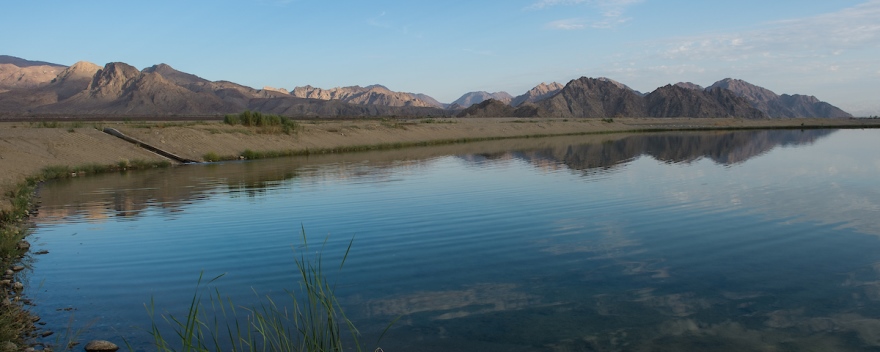
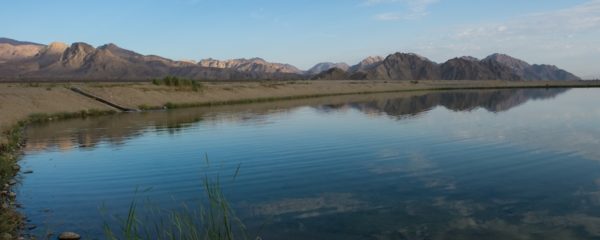
Guest Editors:
Anita Milman, Department of Environmental Conservation, University of Massachusetts Amherst, USA and Michael Kiparsky, Wheeler Water Institute, UC Berkeley, USA
INTRODUCTION: Groundwater pumping exceeds naturally occurring recharge in many regions of the world. The resulting impacts to groundwater systems adversely affect human and environmental systems. Climate change adds urgency, as the combination of more extreme flood and drought regimes coupled with intensifying demand further push groundwater resources out of balance. In many or most groundwater basins, some reduction in groundwater extraction will be necessary to reduce outflows from stressed basins. Increasing inflows to these basins through Managed Aquifer Recharge (MAR) is increasingly looked to as a mechanism to help bring aquifers into sustainable balance.
In this special collection, we examine deployment of MAR in examples from around the USA to illustrate the range of institutional approaches used as well as how those relate to the drivers and objectives of MAR. The overarching impetus for this work is the recognition that water managers often anecdotally agree that institutional elements are as important, or more important, than technical challenges to MAR in many cases.
Articles include the Kern Water Bank, Orange County Water District, and Recharge Net Metering in the Pajaro Valley.
Access all articles at the UC Press by clicking here.
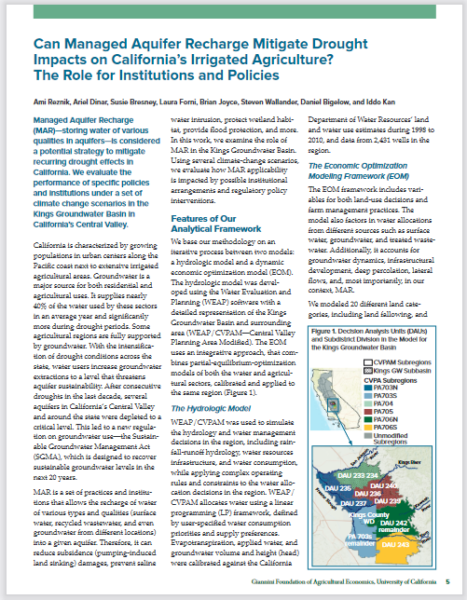 MAR is a set of practices and institutions that allows the recharge of water of various types and qualities (surface water, recycled wastewater, and even groundwater from different locations) into a given aquifer. Therefore, it can reduce subsidence (pumping-induced land sinking) damages, prevent saline water intrusion, protect wetland habitat, provide flood protection, and more.
MAR is a set of practices and institutions that allows the recharge of water of various types and qualities (surface water, recycled wastewater, and even groundwater from different locations) into a given aquifer. Therefore, it can reduce subsidence (pumping-induced land sinking) damages, prevent saline water intrusion, protect wetland habitat, provide flood protection, and more.
In this work, we examine the role of MAR in the Kings Groundwater Basin. Using several climate-change scenarios, we evaluate how MAR applicability is impacted by possible institutional arrangements and regulatory policy interventions.
Click here to read this paper from the Giannini Foundation of Agricultural Economics, University of California.

Floodwaters are not what most people consider a blessing. But they could help remedy California’s increasingly parched groundwater systems, according to a new Stanford-led study. The research, published in Science Advances, develops a framework to calculate future floodwater volumes under a changing climate and identifies areas where investments in California’s aging water infrastructure could amplify groundwater recharge. As the state grapples with more intense storms and droughts, stowing away floodwaters would not only reduce flood risks but also build more water reserves for drier times.
“This is the first comprehensive assessment of floodwater recharge potential in California under climate change,” said study lead author Xiaogang He, an assistant professor in civil and environmental engineering at the National University of Singapore who pursued the research as a postdoctoral fellow at Stanford’s Program on Water in the West.
Click here to read more at Stanford News.
 “Drought has become an issue in California, and one way to help that are vineyards. California Ag Net explains how researchers are using farmland to recharge groundwater.”
“Drought has become an issue in California, and one way to help that are vineyards. California Ag Net explains how researchers are using farmland to recharge groundwater.”
Watch video segment from RFD TV here: Using vineyards to recharge California’s groundwater
For more on groundwater recharge, visit the groundwater recharge page at the Groundwater Exchange by clicking here.












